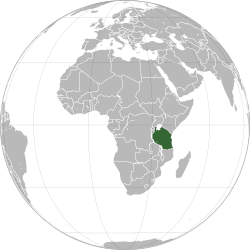Tanganyika (1961–1964)
This article has multiple issues. Please help improve it or discuss these issues on the talk page. (Learn how and when to remove these template messages)
|
Tanganyika (1961–1962) Republic of Tanganyika (1962–1964) | |||||||||
|---|---|---|---|---|---|---|---|---|---|
| 1961–1964 | |||||||||
| Anthem: Mungu ibariki Afrika 'God Bless Africa' | |||||||||
 | |||||||||
| Capital | Dar es Salaam | ||||||||
| Common languages |
| ||||||||
| Demonym(s) | Tanganyikan | ||||||||
| Government | Unitary dominant-party parliamentary monarchy (1961–1962) Unitary dominant-party assembly-independent republic (1962–1964) | ||||||||
| Head of State | |||||||||
• 1961–1962 | Elizabeth II (Monarch) | ||||||||
• 1962–1964 | Julius Nyerere (President) | ||||||||
| Governor-General | |||||||||
• 1961–1962 | Richard Turnbull | ||||||||
| Prime Minister | |||||||||
• 1961–1962 | Julius Nyerere (first) | ||||||||
• 1962 | Rashidi Kawawa (Last) | ||||||||
| History | |||||||||
• Independence from British Empire | 9 December 1961 | ||||||||
• Republic | 9 December 1962 | ||||||||
• Union with Zanzibar | 26 April 1964 | ||||||||
| Area | |||||||||
• Total | 944,842 km2 (364,806 sq mi) | ||||||||
| Currency | East African shilling | ||||||||
| |||||||||
| Today part of | Tanzania | ||||||||
Tanganyika (/ˌtæŋɡənˈjiːkə/) was a sovereign state, comprising the mainland part of present-day Tanzania, that existed from 1961 until 1964. It first gained independence from the United Kingdom on 9 December 1961 as a state headed by Queen Elizabeth II before becoming a republic within the Commonwealth of Nations a year later. After signing the Articles of Union on 22 April 1964 and passing an Act of Union on 25 April, Tanganyika officially joined with the People's Republic of Zanzibar to form the United Republic of Tanganyika and Zanzibar on Union Day, 26 April 1964.[1] The new state changed its name to the United Republic of Tanzania within a year.[2]
History
Tanganyika originally consisted of the Tanganyika Territory, the British share of German East Africa, which the British took under a League of Nations Mandate in 1922, and which was later transformed into a United Nations Trust Territory after World War II. The next largest share of German East Africa was taken into Belgian trusteeship, eventually becoming present-day Rwanda and Burundi.
The Tanganyika Independence Act 1961 transformed the United Nations trust territory into the independent sovereign state of Tanganyika, with Elizabeth II as queen of Tanganyika. The monarch's constitutional roles were mostly exercised by the governor-general of Tanganyika.
Tanganyika adopted a new constitution in 1962 that abolished the monarchy, with the National Assembly (the majority of whom were members of the Tanganyika African National Union Party) drastically revising the new constitution to favor a strong executive branch of government, namely a president.[2] Tanganyika then became a republic within the Commonwealth of Nations, with Julius Nyerere as president of Tanganyika. After the Union of Zanzibar and Tanganyika, an interim constitution amended from the 1962 Constitution became the governing document. Although meant to be temporary, the constitutions remained effective until 1977.[2]
The unification of Tanganyika and Zanzibar in 1964 followed Nyerere's principle of Ujamaa which entailed a strong "territorial nationalism."[3]
See also
References
- ^ The Union of Tanganyika and Zanzibar Act, 1964 (Act No. 22 of 1964) – via WIPO IP Portal.
- ^ a b c Katundu, Mangasini Atanasi; Kumburu, Neema Penance (2015). "Tanzania's Constitutional Reform Predicament and the Survival of the Tanganyika and Zanzibar Union" (PDF). The Journal of Pan African Studies. 8 (3): 104–118.
- ^ Gunderson, Frank (2013). "Expressive Bodies / Controlling Impulses: The Dance Between Official Culture and Musical Resistance in Colonial Western Tanganyika". Soundings: An Interdisciplinary Journal. 96 (2): 145–169. doi:10.5325/soundings.96.2.0145. S2CID 141636812.
- Tanganyika
- Former republics
- Former Commonwealth realms
- Government of Tanzania
- Politics of Tanzania
- States and territories established in 1961
- States and territories disestablished in 1964
- Tanzania and the Commonwealth of Nations
- Tanzania–United Kingdom relations
- 1961 establishments in Africa
- 1964 disestablishments in Africa
- Former member states of the United Nations



